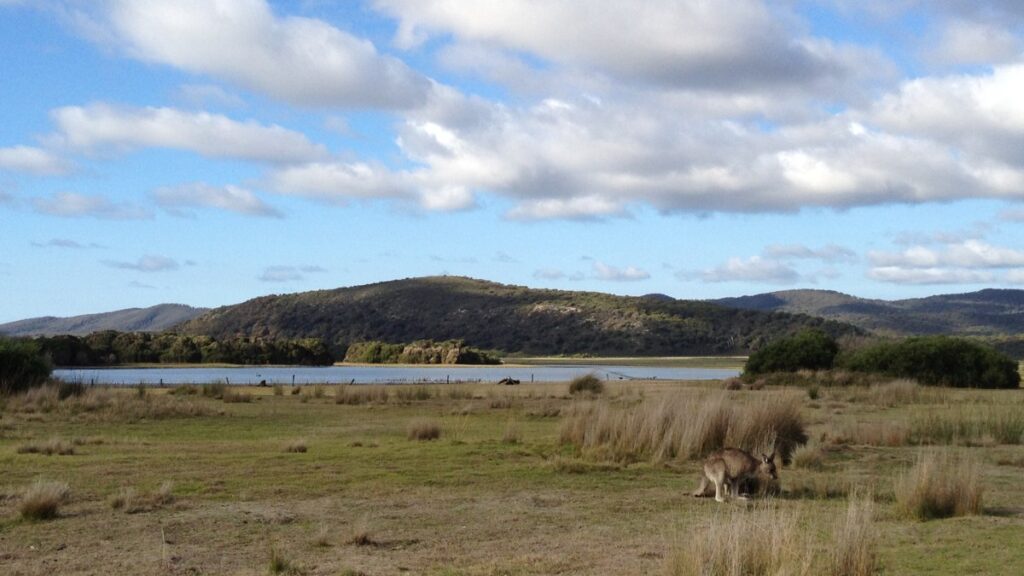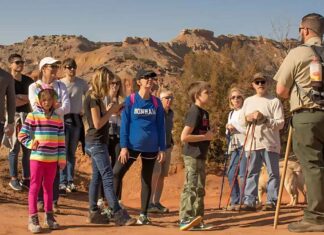
Welcome to our Jersey Gypsy column, where our resident travel reporter, Valentina, roams the globe in pursuit of stories.
After weeks of exploring the best of mainland Australia — diving, dining, and ticking off iconic landmarks — I found myself with an open itinerary and a question: What next?
I was craving something different: a chance to step off the beaten path and into nature. A bit of last-minute Googling brought me to Narawntapu National Park, affectionately dubbed the “Serengeti of Tasmania.”
With its vast plains, wetlands, and abundant wildlife, it felt like the perfect spot to unwind for a day — or even longer if the wallabies lived up to the hype.
I’d heard tales of kangaroos, wombats, and pademelons roaming freely. Still, nothing prepared me for just how close I’d get to them or for the unexpected standoff with what I can only describe as the Mike Tyson of the marsupial world.
A Day Exploring Narawntapu National Park

Stepping foot into Narawntapu National Park feels like entering a living postcard. Its sprawling landscapes are alive with movement, from kangaroos grazing in the distance to birds flitting between trees. But what really sets this park apart is how close you can get to the animals.
For someone like me, used to glimpsing wildlife from a safe (and often distant) vantage point, Narawntapu felt like a backstage pass to Mother Nature’s greatest show.
Getting There: The Journey to Narawntapu
My trip to Narawntapu National Park started with a scenic journey across Tasmania’s northern coast. After catching a quick flight from Melbourne to Devonport, I hopped on a ferry that shipped me closer to my destination.
The water shimmered under a clear sky, triggering memories of my recent adventure into the Great Barrier Reef, and I could feel a similar sense of excitement brewing.
Once I reached the island, the drive to Narawntapu was as picturesque as I’d hoped. Winding roads took me past rolling hills and stretches of farmland, the kind that makes you want to pull over just to soak in the view.
Pulling up near Springlawn, I was already captivated by Tasmania’s rugged charm and eager to see if Narawntapu could live up to its reputation as the “Serengeti of Tasmania.”
The visitor center at Springlawn was my first stop. It was small but welcoming, with helpful rangers who helped me map out the best spots for wildlife viewing and trails suited to my level of ambition (or lack thereof). Armed with my marked-up map, a giant jug of water, and a vague sense of direction, I set out to see what the park had to offer.
First Impression of Narawntapu: A Wildlife Wonderland
What stood out immediately was the abundance of life. Even near the visitor center, the open grasslands were alive with movement — kangaroos lounging in the distance, wallabies darting through the grass, and colorful birds sailing overhead on unseen gusts of wind.
It was like walking into a scene from a nature documentary, except this time, I wasn’t watching from my couch.
As I followed the trail away from the visitor center, the sounds of the park enveloped me. The gentle rustling of the leaves, distant calls of birds, and the occasional thump-thump of something bounding through the brush made me stop and scan the trees for whatever had just darted by.
Every few steps, I had to stop and take it all in. A family of wallabies grazing nearby paused to watch me gush over how cute and fuzzy they were, largely unimpressed by the large, furless visitor.
Nearby, a group of pademelons — tiny, impossibly cute marsupials I’d only seen in photos before — hopped quietly among the trees as if choreographed for the perfect wildlife introduction.
The Kangaroo Encounter: A Close Call
 The trail curved into a sunlit clearing, the kind of spot that felt almost too perfect — like it had been placed there for a movie scene. I was lost in the moment, living for the way the light filtered through the trees, when a sudden rustling caught my attention.
The trail curved into a sunlit clearing, the kind of spot that felt almost too perfect — like it had been placed there for a movie scene. I was lost in the moment, living for the way the light filtered through the trees, when a sudden rustling caught my attention.
I turned, and there it was: a Forester kangaroo, standing just out of arm’s reach, staring at me like I’d interrupted its afternoon plans.
The sheer size of it caught me off guard. It was lean and muscular, with a posture that practically screamed, “This is my neighborhood.”
For a second, my mind jumped to every cartoon and movie I’d ever seen boasting about kangaroos throwing punches like professional boxers.
It’s a hokey trope, sure, but standing there, face-to-face with this kangaroo, I couldn’t help but picture it putting up its dukes. I didn’t know whether I should laugh or run but realized that the best thing to do was not to spook it by making any sudden moves.
The kangaroo, thankfully, didn’t seem that interested in sparring. After a few of the longest seconds of my life, it simply tilted its head, flicked an ear in my direction, and then bounded away with the effortless grace of a dancer leaving a party they never wanted to attend in the first place.
After the adrenaline rush subsided and my heart climbed down from my throat, I realized how lucky I was to have shared this moment.
The “boxing kangaroo” might be a cultural cliche, but the real thing was something else entirely: powerful, curious, and utterly majestic.
Exploring the National Park: Trails, Views, and More
 Narawntapu isn’t the kind of place you rush through. Its beauty demands you slow down a beat, breathe deeply, and let the landscapes unfold at their own pace. As I meandered along the trails, I found myself moving with deliberate slowness, not just to soak it all in but because every step seemed to reveal something new.
Narawntapu isn’t the kind of place you rush through. Its beauty demands you slow down a beat, breathe deeply, and let the landscapes unfold at their own pace. As I meandered along the trails, I found myself moving with deliberate slowness, not just to soak it all in but because every step seemed to reveal something new.
I started with the Bird Hide Walk, a gentle trail that led me through a paperbark forest and onto a boardwalk overlooking the wetlands. The air buzzed with life, from dragonflies zipping just above the water to birds calling out in songs I couldn’t identify but wish I could.
At one point, I spotted a group of black swans gliding along the water’s surface like royalty, their reflections shimmering in the warm light.
Feeling emboldened, I tackled the Archer’s Knob trail next. It is way more of a climb than I expected, but the views from the top were worth every huff and puff.
The sweeping panorama stretched from the grasslands to the sparkling coastline, a patchwork of greens, blues, and gold that made me want to snap a hundred photos — but also just stand there and let the moment sink in.
As I walked by, a shy echidna trundled across the trail, its spiny back catching the sunlight. If you have never seen an echidna in person before (I hadn’t) it is a bit surreal. They look like something from a Star Wars movie with their round, spine-covered bodies and long, thin snouts.
It was in these quieter moments — alone on a trail, surrounded by the hum of nature — the true nature of Narawntapu truly came alive. It’s not just about the wildlife or the scenic views, though both are spectacular.
It’s about feeling like you’ve stepped into a world that’s happy to let you be a part of it, if only for a little while.
Dusk at Narawntapu: A Magical Finale
 As the sun began to sink toward the horizon, the whole park seemed to exhale, settling into a rhythm that felt ancient and eternal.
As the sun began to sink toward the horizon, the whole park seemed to exhale, settling into a rhythm that felt ancient and eternal.
I walked slowly back toward Springlawn, reluctant to leave but eager to get rid of my too-new hiking boots as Narawntapu changed in the soft, golden light of evening.
And change it did. The fields, quiet in the heat of the afternoon, were now alive with movement.
More kangaroos hopped out into the open clearings, their shapes casting long, graceful shadows across the grass. Wallabies grazed in groups, noses twitching, completely unfazed by the humans scattered along the trail.
I found a spot to sit down for a moment at the edge of a clearing, careful not to disturb the scene unfolding before me. The air was cooler now, carrying that earthy scent of dusk that felt so grounding. Somewhere nearby, a bird let out a call — sharp but melodic — and I realized how much quieter the world had become, as if everything was winding down for the night.
And then I saw it: a wombat.
I won’t lie; I’d been hoping to see one all day, and it was even better than I hoped. The little guy emerged from the shadows with an almost comical waddle, looking more like a walking ottoman than a real creature, and I was completely enchanted. It didn’t seem to notice me or care, and I was glad for the chance just to watch.
As the sky shifted from orange to lavender and the first stars began to blink through the twilight, I finished my trek back toward the visitor center. Most of the other hikers had already left, but I had stayed a little longer, unwilling to break the spell.
Narawntapu gifted me a day filled with wonder, a perfect conclusion in an Australian adventure already rich with unforgettable moments like riding the Ghan and visiting popular Aussie restaurants.
It was nature at its most raw and beautiful — a memory etched in sunlight, wildlife, and the gentle rhythm of Tasmania’s wild heart.
Narawntapu Park Info Guide
Planning a trip to Narawntapu National Park? Here are a few things I wish I’d known before I went — and some tips to help you make the most of your visit.
What to Pack
- Comfortable, Broken-in Shoes: Trust me, your feet will thank you. My boots were not broken in, and while they made it through, they rubbed me raw in the process.
- Layers: Tasmania’s weather can shift faster than a kangaroo deciding you’re not worth its time. Pack a light jacket for cooler evenings.
- Water and Snacks: The trails don’t have vending machines, so come prepared. A large, refillable water bottle and some trail mix will go a long way.
- Binoculars: I didn’t bring any, and I regret it. Whether it’s for birdwatching or spotting wildlife at a distance, they’ll come in handy.
Best Times to Visit
Early mornings and late afternoons are the golden hours at Narawntapu. This is when the wildlife is most active, and you’re more likely to spot kangaroos, wombats, and wallabies grazing in the open.
During the hottest parts of the day, most creatures are keeping to the shade as much as possible.
What to Expect
- Trails for Everyone: Whether you’re looking for a gentle walk (try the Bird Hide Walk) or a more adventurous hike (Archer’s Knob), there is something for all fitness levels.
- Plenty of Wildlife: You’ll see kangaroos, wallabies, pademelons, echidnas, and even a wombat if you’re lucky. The animals are used to people — but don’t take it personally if they completely ignore you.
- Helpful Rangers: The staff at the visitor center are fantastic and can recommend trails or wildlife hotspots based on how much time you have.
Tips for Respecting the Park
- Stay on designated trails to protect the habitat and avoid disturbing wildlife.
- Keep your distance from the animals. They’re adorable, but they’re still wild creatures (and you really don’t want to end up in a staring contest with a kangaroo — trust me).
- Leave no trace. Take your trash with you and help keep Narawntapu as pristine as it is today.
Reflecting on the Wild Wonders of Narawntapu
 Narawntapu National Park ended up being much more than a detour on my Australian adventure — it was a reminder of how profound even the simplest moments in nature can be.
Narawntapu National Park ended up being much more than a detour on my Australian adventure — it was a reminder of how profound even the simplest moments in nature can be.
From squaring up against a Forester kangaroo to witnessing the quiet waddle of a wombat at dusk, every part of the day felt like a gift.
This park invites you to slow down, breathe deeply, and truly immerse yourself in its tranquility. Whether you’re a seasoned hiker, an animal lover, or just someone looking for a slice of peace, Narawntapu offers a rare opportunity to reconnect with nature and rediscover a sense of self.
Would I go back? In a heartbeat!
FAQs About Narawntapu National Park
What Is Narawntapu National Park?
Narawntapu is a coastal national park on Tasmania’s northern coast, known for its open grasslands, wetlands, and abundant wildlife. Often called the “Serengeti of Tasmania,” it’s one of the best places to see kangaroos, wallabies, wombats, and more in their natural habitat.
When Is the best time to visit Narawntapu Park?
Early mornings and late afternoons are the best times to visit Narawntapu, as it is ideal for wildlife activity. If you’re hoping to see wombats, aim for dusk when they’re the most active.
Can You Pet or Feed the Animals?
No, you can’t pet or feed the animals at Narawntapu National Park. The animals here are wild and should be admired from a distance. Feeding them is strictly prohibited as it can harm their health and disrupt their natural behaviors.
Is the Park Suitable for Kids?
Absolutely! With gentle trails and plenty of wildlife to see, Narawntapu is an excellent place for families. Just remind the little ones to stay quiet and respectful around the animals.
How Do You Get to Narawntapu National Park?
Getting to Narawntapu National Park is easy. It’s about a 30-minute drive east of Devonport or an hour from Launceston. You can drive to the main entrance near Springlawn, and parking is available.
How Much Does It Cost to Visit Narawntapu National Park?
To visit Narawntapu National Park, you’ll need a valid park pass, which starts at around $20 per vehicle or $10 per individual for a daily pass. Multi-day or annual passes are also available if you’re exploring more parks in Tasmania.










